Uit: THE HORSELESS AGE. Vol. 30, No. 6. August 7, 1912
(Geen artikel van een Conam-lid, maar interessant genoeg om te publiceren)
The Flat, Picturesque Dutch Country Offers Many Delightful Opportunities for Touring-Roads Well Kept and Automobile Regulations Liberal—Ripe Field for the Development of American Trade—Opportunities for American Agencies.
By Frank W. Mahin.
In various respects Holland is an ideal country for automobiling. Except in the eastern part, near the German frontier, it is perfect1y flat, and outside the towns and cities is generally without obstructions to the view ahead and on the sides. The rural scenery is composed chiefly of pastures covered with black-and-white cattle, many of which are blanketed during inclement weather, or with sheep of burly proportions, and is interspersed with vegetable and grain fields.
The monotony of the utter flatness is relieved by many canals, serving as boundary lines between farms or as avenues of trade, which carry boats propelled by poles or gasoline motors or by sails, when the novel distant effect is of a schooner gliding over the fields, among the sheep and cattle. All the landscape besides is dotted with windmills, busily pumping water in or out of canals, grinding wheat or sawing logs. Many of the windmills are several stories high, serving both as residences and as motors.

Type of Dutch Commercial Vehicles.
In April and May, in an oblong district between Haarlem and Leiden, some thousands of acres are brilliant with the variegated hues of tulips and hyacinths. They are cultivated for the bulbs, which are sold to all parts of the world. The flowers are a mere incident, and arc given away freely or used as a fertilizer for other than bulb fields.
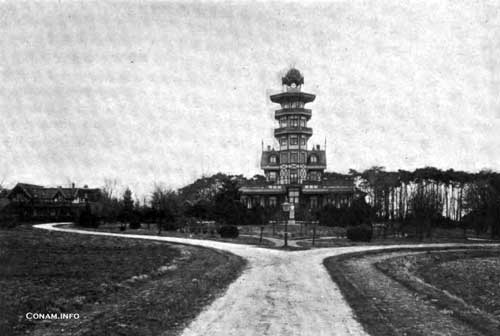
Some Quaint Dutch Architecture at the Division of Road Near Hilversum in the Province of North Holland.
The villages, towns and cities arc picturesque, with antique houses, native costumes and the inevitable intersecting canals, burdened with traffic and crossed by frequent bridges.
Neither in urban nor in rural localities, so far as the writer has knowledge, is there now any antipathy to or maltreatment of automobiles and automobilists; and the recorded accidents are few.
ROADS WELL CARED FOR.
The main roads are generally brick paved, though sometimes the paving is of square stone blocks or of gravel, and there is occasional macadam. The roads are constructed and maintained by the respective communities through which they pass, but are all under the control of a Government department, which places engineers in different parts of the country to see that they are kept in good repair. The nature of the ground in this low-lying country requires a very solid foundation for the roads.
The substructure is usually of broken stone laid to a depth of about 15 inches. Over this comes a layer of sand, and then the superstructure of brick, stone, etc. The roads are slightly convex, for draining purposes. The brick and stone roads are as dustless as any road possibly could be, for all dirt not blown off by wind is washed off by rain, aided by the convex surface.
On the gravel and macadam roads, however, the customary dust exists; but these have the virtue of greater smoothness than the brick and stone thoroughfares, though it must not be inferred that the latter are rough—only that they are less velvety than a well-rolled gravel or macadam road. Lately, with the development of automobile traffic, a beginning has been made in oiling dusty roads.
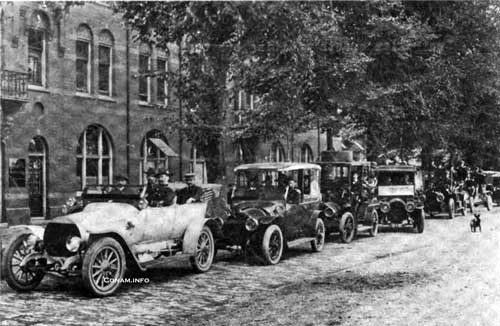
Australian Cadets Visiting an Amsterdam Automobile Factory.
The roads are generally lined with planted trees, small along new roads, but large enough for shade on the older. The oldest roads are virtual arbors, with the branches of large trees reaching across and interlacing with those on the other side.
Most of the roads are now free. Formerly there were many toll gates, but they have been gradually abolished, till now there are about twenty, those being on semi-private roads. The toll for an automobile is from 4 to 8 American cents.
AUTOMOBILE REGULATIONS.
There is no legal restriction upon the weight or character of automobile traffic in Holland, so the writer is informed, excepting that a special license is required where the weight exceeds 6,000 kilograms (13,228 pounds). On the public rural roads no speed limit is prescribed, and this is also true of Amsterdam and some other cities.
But the automobilist is held to strict accountability for any damage or casualty which he may cause. However, each gemeente (community) makes its own regulations. A gemeente may consist of one considerable town, or of one town and one or more nearby villages and the intervening country. There are usually speed regulations for each town or village, but the speed restrictions are not uniform, ranging from ten to forty miles. an hour in different gemeentes.
Besides, some cities have restrictions as to certain streets. In The Hague the speed in a very narrow and crooked street is limited to ten kilometers (6.2 miles) an hour. In Amsterdam a special license is necessary to drive an automobile through certain narrow and crowded streets, one of which cannot be entered except at one specified end, and the speed must be very slow—about the walking gait of a horse.
In many towns and villages certain streets are closed entirely to motor car traffic-the prohibition being indicated at each end and at street intersections by a sign with white letters on a red background or vice versa; or certain streets may be closed at given hours each day. and others may entirely exclude automobiles above a specified weight.
Bricks and stone blocks are the predominant paving materials in the cities, but in Amsterdam, for instance, they are being displaced on many prominent streets by asphalt, with wood blocks between the street car tracks.
CITIZENS EXEMPT FROM LICENSING.
Citizens of Holland pay no license fee for automobiles. On entering this country foreigners who produce the documents issued under the auspices of the International League of Automobile Clubs can travel through Holland without a domestic license. Otherwise, the foreign automobilist must take out a Dutch license. He can obtain one for eight days at the custom house on the frontier without charge. If he wishes to remain longer in the country he can obtain a more extended license by applying to the Minister of Commerce and Industry at The Hague, the only charge therefor being the value of the stamp on the document—about 40 cents.
The duty on automobiles imported into Holland is 5 per cent, ad valorem. The foreigner, on reaching the frontier, may arrange this by depositing the amount of the duty at the custom house there, to be returned to him on leaving the country; or by depositing a certificate from a club belonging to the International League, issued against a security placed in a bank. The latter is considered the simpler and easier proceeding, and obviates the necessity of returning to the place of entry on leaving the country.
Resident owners of automobiles are annually taxed $12 to $100 on each machine, the amount varying with the horse power. For electric motor cars the uniform annual tax is $48.24.
GOVERNMENT REGULATIONS.
In addition to the local regulations mentioned, the National Government prescribes certain rules applicable to the whole country.
Every automobile must have a proper letter and number, and every driver must have a certificate, which is not issued to any person under eighteen years of age.
No automobile races can occur on public roads without special permission from the Minister of Commerce and Industry.
Drivers must keep to the right side of the road when meeting other vehicles, and also when overtaken by other vehicles wishing to pass; and must go to the left when overtaking and passing another vehicle.
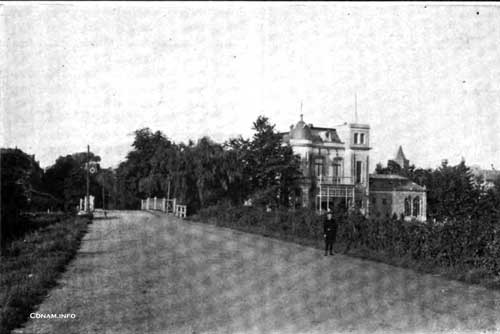
A Section of a Well Kept Road in the Province of Utrecht.
Automobiles must be equipped to move backward. They must have at least two effective brakes, acting independently of each other and both within the chauffeur's reach. If one of the brakes does not act immediately on the wheels, the car must be provided with a device to prevent its running backward on a steep slope.
Every automobile must have a horn which can be heard at least 300 feet; no other signal may be used in towns and villages.
Half an hour after sunset and before sunrise an automobile must have at least two lanterns casting a white light in front. In towns and villages projecting lanterns which blind the eyes cannot be used.
A driver must not leave his car on a road unattended unless he stops the motor.
The regulations prohibit driving at a speed or in a way that would be dangerous to traffic on any road, thereby leaving the question of culpability to be determined in each particular case of accident. Apparently this is a wholesome provision, for accounts of automobile accidents in this country are rare.
ONLY 2,600 CARS IN HOLLAND.
According to official statistics there were at the end of last year 250 automobiles in Amsterdam (population, 580,000), 298 in The Hague (population, 285,000) and 110 in Rotterdam (population, 430,000). In addition there were 50 automobile taxis in Amsterdam, 55 in The Hague and 12 in Rotterdam. Twenty per cent, added to the foregoing figures would give the approximate number at the present time. The official statistics gave 2,606 as the total number of automobiles in the entire country at the end of 1911. The number is increasing at the rate of about 500 a year, and is now estimated at about 3,000.
More than half of these cars are in the two provinces of North and South Holland, containing the cities of Amsterdam, Rotterdam and The Hague, but with less than half the population of the whole country. The obvious reason is that more affluent people live in and about those cities than in other provinces.
As Holland's population is 6,000,000 and its number of automobiles 3,000, the ratio is one machine to each 2,000 people—very small compared with some other countries. This is presumably due to the innate conservatism of the rich Hollander, which prompts him to cling .to his elegant carriage and span, and also to the economic prudence of the not-rich Hollander, which restrains him from buying what he cannot readily pay for and easily maintain after purchase. It cannot be wholly due' to relative inability to buy automobiles; for while there are few very rich people in Holland, the number in easy circumstances is large, and the prudence and general temperance of the average Dutchman fill the savings bank with his surplus earnings.
According to the opinion of credit agencies and to other reliable sources of information, about one person in each thousand of this country's population has a sufficient income to permit him to buy and maintain a motor car without incurring debt. As the number of automobiles is now but one to each 2,000 of the population, the scope and character of the possibility in Holland is apparent from this opinion.
HOLLAND A FERTILE AUTOMOBILE FIELD.
Evidently Holland is almost a virgin field and ought to be a rich one for the development of the automobile trade. Conservatism must be overcome, but that can be gradually accomplished, and, in fact, is now being accomplished. This conservatism is found chiefly in the older people, and but little in the younger. As power and possessions are taken over by the younger generation the carriage and span will be replaced by the automobile, and this process is now in action, and is being materially assisted by a large and growing number of agents and manufacturers of automobiles.
CANALS VS. COMMERCIAL MOTORS.
Contrariety of opinion exists regarding the field for commercial motor vehicles in Holland. There are now but few here--probably a dozen in Amsterdam and thirty in all Holland. The profusion of canals in the cities—there are enough in Amsterdam to require 300 bridges to carry the streets across them—brings products of all kinds so close to shop and warehouse doors that often no vehicle is needed; and where more than hand power is required to transfer goods from boat to building, the distance is usually so short that a motor vehicle is considered altogether supererogatory. As to railway freight and deliveries by retail stores, the case is very different. On the whole, motor vehicle dealers are sanguine that Holland offers a rich field for commercial vehicles.
Satisfactory hotels are found in all the Dutch towns and villages, and wayside inns are scattered along the country roads. They are generally fairly inexpensive, and are reputed to be clean and comfortable. In all towns of consequence there are garages and repair shops, and the automobile is now so well known in Holland that mechanics can be found in almost any village who can make ordinary repairs.
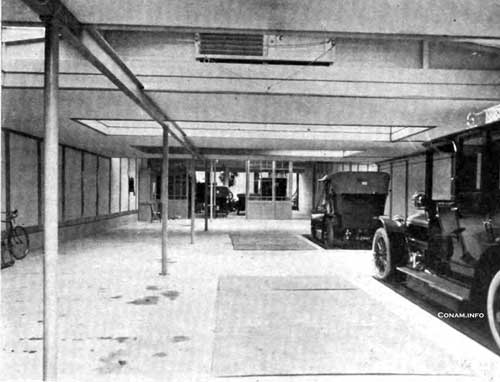
Inside view of a Modern Dutch Automobile Garage.
CLUBS PROMOTE COMPETITION.
There is a National Automobile Club with 1,100 members. Another state wide organization with 30,000 members includes automobiles, bicycles and motorcycles. Competitions occur from time to time under the auspices of the clubs. A speed and endurance trial for automobiles is arranged for July, over a course of some fifty miles, from Nymegen, Holland, to a point in Belgium. A competitive exhibition of commercial motor vehicles is planned for September. The details are not yet complete, but it is understood that the vehicles will traverse a large part of Holland, taking in the important cities.
As the automobile trade expands in this country there is a growing interest in competitions and an increasing disposition to produce them.
Few open motors cars are bought or used in this country. Ninety per cent, of the automobiles are closed, and are of the landaulet and limousine types. The landaulet giving an open car in summer and a closed car in winter is rather the most favored.
AMERICAN CARS NOT POPULAR.
Of the automobiles owned in Holland about 20 per cent, are of Dutch manufacture, 30 per cent. French, 18 German, 10 Belgian, 10 English, 7 American and 5 Italian. There are three automobile factories in this country. The various different foreign cars represented here by agencies or otherwise are two Italian, four American, four English, five Belgian, eighteen German and nineteen French.
A distinct prejudice exists in this country against American automobiles in the minds of both dealers and buyers. It is explained by the allegation that some American cars sold in Holland several years ago were so inferior in material and workmanship that it was afterward considered unsafe to deal in them, especially when there were cars galore which had stood all tests and were entirely satisfactory.
It is alleged, besides, that American manufacturers will grant no credits whatever; that nobody will buy a car without first seeing it, and that a would-be agent cannot even secure a sample American car without paying for it in advance, which, as a rule, he will not do. The further objection is made that America is too far away to get quickly required parts.
The only apparent way to overcome these difficulties is to establish in this country one or more depots carrying samples of automobiles and stocks of supplies in charge of competent men, both American and Dutch. Then actual demonstration of the excellent quality of American machines and liberality in the treatment of would-be buyers would undoubtedly open the market as widely to American automobiles as to those of any other country; for the Dutch people have a warm feeling for the United States, which disposes them to give a preference to our country over some other countries when conditions are equal.
OVERCOMING PREJUDICE.
However, progress has been made this year in overcoming the prejudice against American automobiles, for the Amsterdam agent of an American car informs the writer that he has sold thirty since the first of January, and that they have all given entire satisfaction to the purchasers. This instance apparently shows that through special and energetic representation a demand for American automobiles can be created here.
The following dealers now handle American automobiles:
M. Adler, Prinsengracht 581-583, Amsterdam.
A. J. H. Ceurvorst, Alber Cuypstraat 253, Amsterdam.
Nederlandsche Auto Handel My., Beerenstraat 17, Amsterdam.
Auto Palace, Houtweg, The Hague.
Nederlandsche Auto Handel My., The Hague.
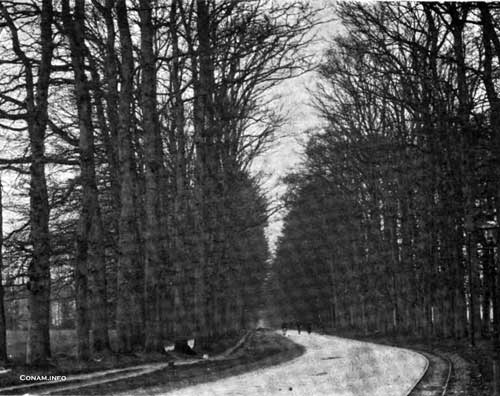
Picturesque Road Near the Hague.
PROSPECTIVE AMERICAN AGENCIES.
Gerard M. Dee, automobile dealer, Breestraat 28, Leiden, announces that he would like to represent some large American factory, which can furnish a well made car at a comparatively low price—say from $750 to $1,000.
The following dealers might handle American automobiles if as favorable terms and conditions as are offered by other foreign countries could be obtained:
Verwey & Lugard, Plantage Muidergracht 6, Amsterdam.
J. Leonard Lang, Stadhouderskade 114, Amsterdam.
Gebr. Willink, Weteringschans III, Amsterdam.
J. G. A. W. Mulder, Pieter Basstraat 25, Amsterdam.
A. Darracq & Co., Stadhouderskade 100-101, Amsterdam.
M. v. Genderingen & Co., Falckstraat, Amsterdam.
M. Adler, Prinsengracht, 581-583, Amsterdam.
Julius Holz, Prinsengracht 278-282, Amsterdam.
M. Oostmeyer, Casuariestraat 7, The Hague.
H. Englebert & Co., Bezuidenhout 71, The Hague.
L. W. K. Lanen, Koninginnegracht ic, The Hague.
Protos Automobile My., Noordwal 3c, The Hague.
N. Verwey & Lugard, Laan v. N. O. 178, The Hague.
Haagsche Automobile My., Koninginnegracht, The Hague.
R. S. Stokvis & Sons, Rotterdam.
W. H. Bayer, Rotterdam.
E. J. Eilers v. Dam, Rotterdam.
A. Smits, Rotterdam.
Wilhelmi & Co., Rotterdam.
Held's Sporthandel, Rotterdam.
Possibly there are still other firms in this country that could be named, but the foregoing lists comprise the addresses of such firms as are generally known to be dealing in American automobiles, or who it is understood would consider propositions to handle such cars.

